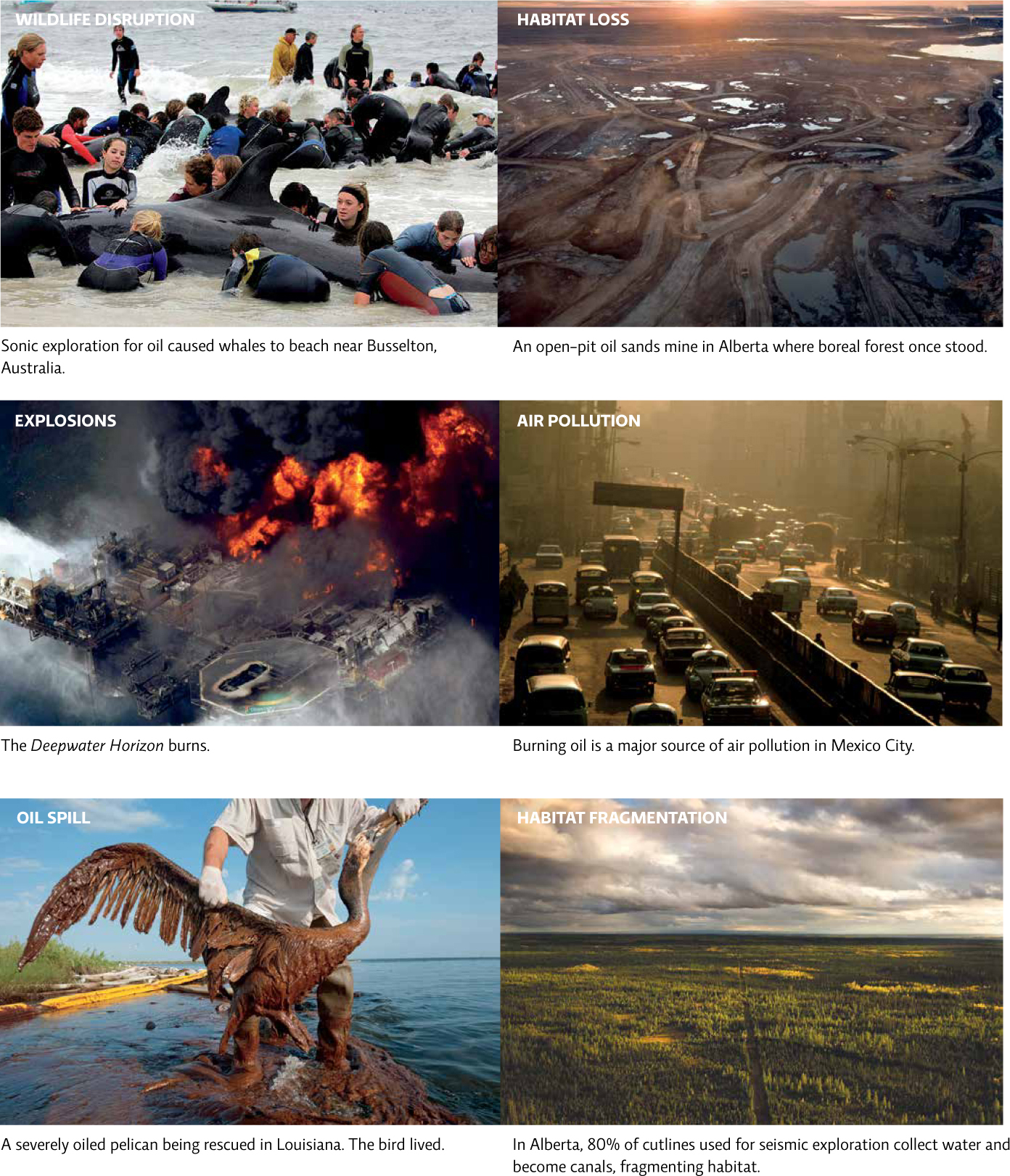20.5 Oil use comes at a great cost.
Oil extraction is not just financially expensive—it also has environmental consequences at every stage. In order to find sources of oil, companies send seismic waves into the ground that bounce back to reveal the location of possible reserves. But doing so disorients marine wildlife; in 2009, ExxonMobil had to abandon its oil exploration in Madagascar because more than 100 whales had beached themselves, presumably as a result of these seismic exploratory methods.
Drilling can affect wildlife, too. U.S. politicians have long debated the merits of drilling in the Arctic National Wildlife Refuge (ANWR), nearly 70 000 square kilometres of protected wilderness. The U.S. Geological Survey estimates that parts of ANWR located on the northern Alaskan coast could harbour up to 16 billion barrels of crude oil and natural gas reserves. But drilling there— which could begin in the coming decades—would have serious environmental consequences. The coastal area where drilling would take place is home to Arctic foxes, caribou, polar bears, and migratory birds, all of whose habitats could be disturbed by the drilling, affecting migrating populations across Canada and Alaska.
And damage is not limited to the extraction of fossil fuels. Processing and shipping of fossil fuels generates air and water pollution. Pollution generated when fossil fuels are burned is also a major source of air pollution (see Chapter 21) and a main cause of climate change (see Chapter 22). Transporting the oil is another environmental concern and the construction of oil pipelines to carry the oil sands oil to refineries is hotly contested. The proposed Keystone XL pipeline, which would deliver oil from the Alberta oil sands to Texas refineries, is opposed by environmental groups and Canadian and U.S. citizens along its proposed route. An alternative proposal, the Northern Gateway pipeline, would construct a pipeline to take the oil west through British Columbia for export to Asian markets, also sparking protests among residents in rural and urban areas along the proposed path. [infographic 20.8]

361
362
The more development Schindler saw around the Athabasca River, the more concerned he became. Initially, both the Alberta government and a monitoring group funded by the oil industry claimed the mining wasn’t causing any damage to nearby environments.
But Schindler wasn’t so sure, so he and his colleagues, NOAA scientist Jeffrey Short (now at Oceana) and Peter Hodson of Queen’s University in Ontario, decided to embark on a one-year project to survey the area. They collected water samples from multiple spots along the river and its tributaries in the winter and summer of 2008, then brought them back to the lab to analyze for pollutants.
During the winter, Schindler’s then graduate student Erin Kelly led a team of people that took samples of the snowpack near the river, which contained months of precipitation that may have accumulated toxins. Sometimes, collecting samples from such remote areas wasn’t easy, Schindler recalls, and relied on a combination of boats, snowmobiles, and helicopters. “In some places, there was so much snow we couldn’t tell if the ice was thick enough to land the helicopter, so they would hover the vehicle over the ground and reach down to collect samples.”
The scientists found that concentrations of 13 toxic compounds were higher in the tributaries located downstream of oil sands mining than those located upstream, which suggests that the extraction is at least partly responsible. Also of concern were the huge lakes of acidic and toxic wastewater that oil companies store at the mining sites as a by-product of the refining process. The pools are so large that they can be seen from space.
Some contaminants were present at levels 25-50 times higher than those found in areas further from oil sands development. “We knew we would see some contamination, but we didn’t know how high it would be,” says Schindler, who published his findings in 2009 and 2010.
Schindler and his colleagues found a “bull’s-eye” concentration of contamination, highest right around the area where bitumen is mined and processed. This suggests that the industry is playing a significant role. But critics note that small amounts of the compounds are naturally present in the area and since monitoring these compounds only began after the industry moved in, no one knows what the original, natural baseline levels are.
To determine what background or “normal” contamination might be, Joshua Kurek of Queen’s University examined sediment cores from area lakes, digging deep enough to examine sediments in the years that preceded oil sands extraction. He found toxins linked to oil sands at much higher levels in recent years (2.5-23 times higher than 1960 levels), establishing a pre-development baseline and linking oil extraction to pollution in the area.